Implementation of Different PV Forecast Approaches in a MultiGood MicroGrid: Modeling and Experimental Results
Abstract
:1. Introduction
2. PV Forecast Models
2.1. Day Ahead
2.2. Intraday
- Time parameters: day of the year () and hour of the day () corresponding Timestamp to be forecast;
- Ambient parameters: global horizontal irradiation () and the Irradiation on the plane of the array () collected the previous day from the provider and already used to compute the forecast power with the 24 h ahead logic;
- Forecast power obtained with the 24 h ahead logic ();
- The last forecast error available ();
- The current measurements for the weather parameters ( and ).
2.3. Nowcasting
3. EMS with PV Forecast Implementation
3.1. First Layer Model
3.2. Second Layer Model
4. Experimental Setup
4.1. Microgrid Description
- Two PV fields made up of monocrystalline panels (327 kWp), for a total installed capacity of 49 kWp;
- Two solar inverters of 25 kWel each coupled with the PV fields for maximum power point tracking;
- One 70 kW/67.5 kWh lithium-ion BESS;
- One 25 kWel asynchronous generator, fueled by natural gas (ICE);
- One reverse osmosis desalination system, or water purifier (WP), with an associated water tank, to increase the flexibility of potable water production;
- One back-to-back inverter (B2B) that interfaces the MG2Lab with the distribution network while decoupling voltage and frequency of the MG for off-grid operations; is used to simulate an electric load profile.
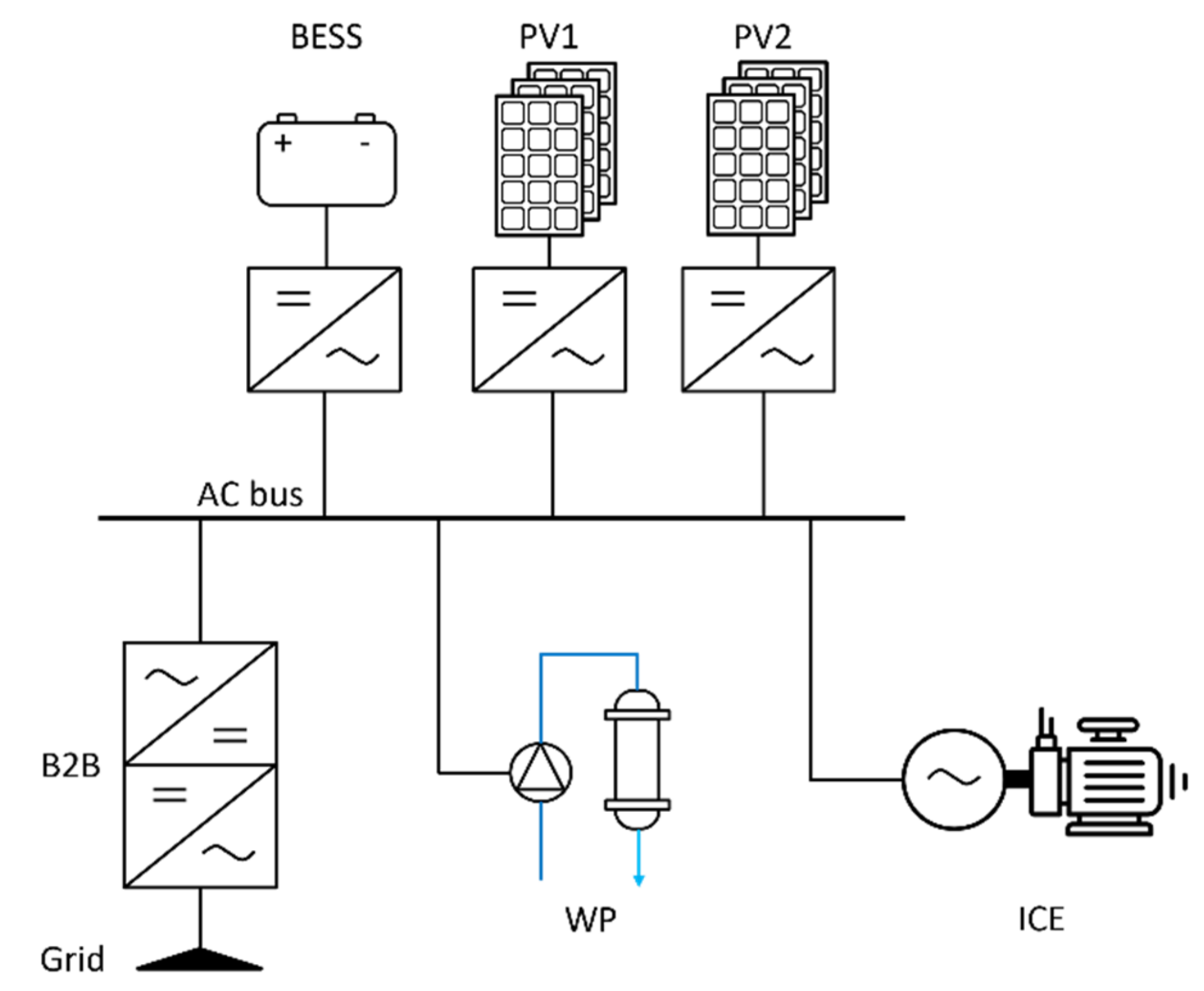
| Min. Out | Max. Out | Ramp Limit | |
|---|---|---|---|
| BESS | −70 kW | 70 kW | --- |
| ICE | 12.5 kW | 25 kW | 3 kW/min |
| WP | 650 L/h | 1000 L/h | 150 L/min |
4.2. EMS Implementation
- Workstation: the software corresponds to the first layer of the hierarchical EMS, thus including the forecasting and the optimization modules. They are assigned to cyclic tasks in the Matlab environment through timer objects. The first layer problem is defined over a horizon of 24 h with a resolution of 15 min, and it is solved in a rolling horizon, with an advancement time of 15 min. The forecasting module updates the PV profiles and sends the new information in synchronism with the timing of the selected forecast methods. Moreover, the Matlab software communicates with the PLC through the MODBUS interface, sending the set-point and collecting the measurements of the MG status every 20 s.
- PLC: the second layer is implemented on the PLC software since only one programmable generator is included in this setup, meaning that the proposed second layer problem is simplified, and the solution of the LP is no longer required. Thus, the PLC receives from the first layer the reference SOC and the commitment and directly computes the set-point of the programmable generators with a discretization of 100 ms, following the scheme presented in Section 3.2.
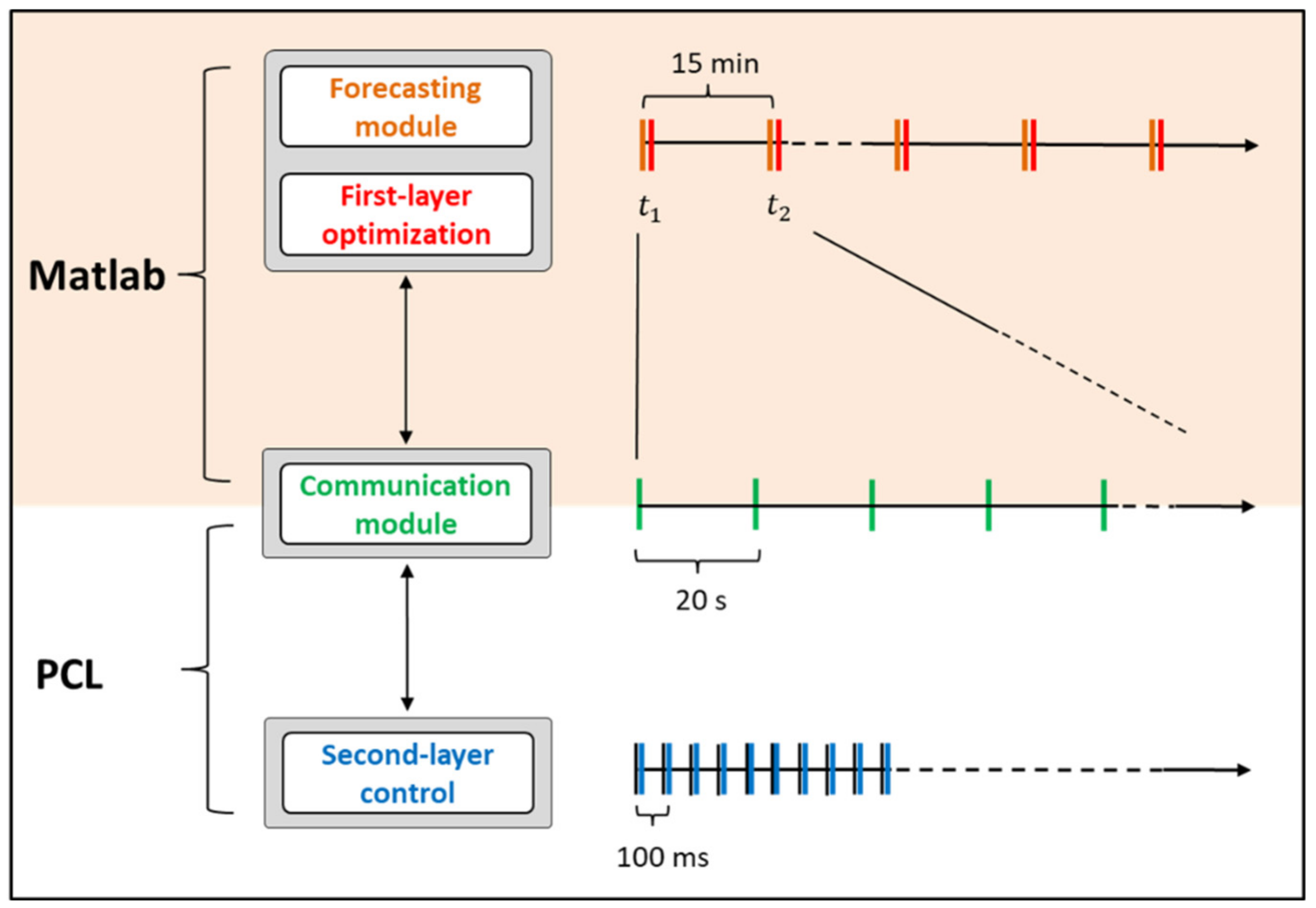
4.3. Case Study Definition
5. Experimental Results
5.1. Day 1–Experimental EMSDA
5.2. Day 2–Experimental EMSINT
5.3. Day 3–Experimental EMSNC
5.4. Discussion
6. Conclusions
Author Contributions
Funding
Institutional Review Board Statement
Informed Consent Statement
Conflicts of Interest
Appendix A
| Set and Indices | |
|---|---|
| Timestep | |
| Generic MG unit | |
| MG good | |
| Programmable generator | |
| Fossil-fueled generator | |
| Generator producing/consuming good | |
| Storage system | |
| Storage system participating in good balance | |
| Non-dispatchable generator (RES unit) | |
| Non-dispatchable generator producing good | |
| Parameters | |
| Forecasted demand of good | |
| Forecasted generation of non-dispatchable generator | |
| Expected increase of demand | |
| Expected decrease of non-dispatchable generation | |
| Expected net demand for spinning reserve | |
| Minimum/maximum output of unit | |
| Ramp-up/ramp-down limit of unit | |
| Maximum ramp during startup/shut-down | |
| Minimum up-time/down-time | |
| Coefficient for linear formulation of input/output relation | |
| Generic cost coefficient | |
| Variables | |
| Commitment status of generator | |
| Startup and shut-down decisions of generator | |
| Consumption and production of generator | |
| Storage content (SOC) | |
| Bus balance for storage | |
| Charging and discharging power for storage | |
| Auxiliary binary variable for storage | |
| Unmet demand of good | |
| Curtailment of non-dispatchable generation | |
| Reserve contribution from unit | |
References
- Lasseter, R.H. MicroGrids. In Proceedings of the 2002 IEEE Power Engineering Society Winter Meeting, Conference Proceedings (Cat. No.02CH37309), New York, NY, USA, 27–31 January 2002; Volume 1, pp. 305–308. [Google Scholar]
- Hatziargyriou, N.; Asano, H.; Iravani, R.; Marnay, C. Microgrids. IEEE Power Energy Mag. 2007, 5, 78–94. [Google Scholar] [CrossRef]
- Hirsch, A.; Parag, Y.; Guerrero, J. Microgrids: A review of technologies, key drivers, and outstanding issues. Renew. Sustain. Energy Rev. 2018, 90, 402–411. [Google Scholar] [CrossRef]
- Mancarella, P. MES (multi-energy systems): An overview of concepts and evaluation models. Energy 2014, 65, 1–17. [Google Scholar] [CrossRef]
- Zia, M.F.; Elbouchikhi, E.; Benbouzid, M. Microgrids energy management systems: A critical review on methods, solutions, and prospects. Appl. Energy 2018, 222, 1033–1055. [Google Scholar] [CrossRef]
- Olivares, D.E.; Mehrizi-Sani, A.; Etemadi, A.H.; Cañizares, C.A.; Iravani, R.; Kazerani, M.; Hajimiragha, A.H.; Gomis-Bellmunt, O.; Saeedifard, M.; Palma-Behnke, R.; et al. Trends in microgrid control. IEEE Trans. Smart Grid 2014, 5, 1905–1919. [Google Scholar] [CrossRef]
- Hernandez, L.; Baladron, C.; Aguiar, J.M.; Carro, B.; Sanchez-Esguevillas, A.J.; Lloret, J.; Massana, J. A Survey on Electric Power Demand Forecasting: Future Trends in Smart Grids, Microgrids and Smart Buildings. IEEE Commun. Surv. Tutor. 2014, 16, 1460–1495. [Google Scholar] [CrossRef]
- Khan, A.A.; Naeem, M.; Iqbal, M.; Qaisar, S.; Anpalagan, A. A compendium of optimization objectives, constraints, tools and algorithms for energy management in microgrids. Renew. Sustain. Energy Rev. 2016, 58, 1664–1683. [Google Scholar] [CrossRef]
- Mazzola, S.; Astolfi, M.; Macchi, E. A detailed model for the optimal management of a multigood microgrid. Appl. Energy 2015, 154, 862–873. [Google Scholar] [CrossRef]
- Malysz, P.; Sirouspour, S.; Emadi, A. An optimal energy storage control strategy for grid-connected microgrids. IEEE Trans. Smart Grid 2014, 5, 1785–1796. [Google Scholar] [CrossRef]
- Meng, L.; Sanseverino, E.R.; Luna, A.; Dragicevic, T.; Vasquez, J.C.; Guerrero, J.M. Microgrid supervisory controllers and energy management systems: A literature review. Renew. Sustain. Energy Rev. 2016, 60, 1263–1273. [Google Scholar] [CrossRef]
- Moretti, L.; Polimeni, S.; Meraldi, L.; Raboni, P.; Leva, S.; Manzolini, G. Assessing the impact of a two-layer predictive dispatch algorithm on design and operation of off-grid hybrid microgrids. Renew. Energy 2019, 143, 1439–1453. [Google Scholar] [CrossRef]
- Valibeygi, A.; Konakalla, S.A.R.; de Callafon, R. Predictive Hierarchical Control of Power Flow in Large-Scale PV Microgrids with Energy Storage. IEEE Trans. Sustain. Energy 2020, 12, 412–419. [Google Scholar] [CrossRef]
- Luna, A.C.; Meng, L.; Diaz, N.L.; Graells, M.; Vasquez, J.C.; Guerrero, J.M. Online Energy Management Systems for Microgrids: Experimental Validation and Assessment Framework. IEEE Trans. Power Electron. 2018, 33, 2201–2215. [Google Scholar] [CrossRef]
- Polimeni, S.; Moretti, L.; Manzolini, G.; Leva, S.; Meraldi, L.; Raboni, P. Numerical and experimental testing of predictive EMS algorithms for PV-BESS residential microgrid. In Proceedings of the 2019 IEEE Milan PowerTech, Milan, Italy, 23–27 June 2019; pp. 1–6. [Google Scholar]
- Parisio, A.; Rikos, E.; Glielmo, L. A Model Predictive Control Approach to Microgrid Operation Optimization. IEEE Trans. Control Syst. Technol. 2014, 22, 1813–1827. [Google Scholar] [CrossRef]
- Hooshmand, A.; Asghari, B.; Sharma, R.K. Experimental demonstration of a tiered power management system for economic operation of grid-tied microgrids. IEEE Trans. Sustain. Energy 2014, 5, 1319–1327. [Google Scholar] [CrossRef]
- Elkazaz, M.; Sumner, M.; Thomas, D. Energy management system for hybrid PV-wind-battery microgrid using convex programming, model predictive and rolling horizon predictive control with experimental validation. Int. J. Electr. Power Energy Syst. 2020, 115, 105483. [Google Scholar] [CrossRef]
- Sachs, J.; Sawodny, O. A Two-Stage Model Predictive Control Strategy for Economic Diesel-PV-Battery Island Microgrid Operation in Rural Areas. IEEE Trans. Sustain. Energy 2016, 7, 903–913. [Google Scholar] [CrossRef]
- Wan, C.; Zhao, J.; Member, S.; Song, Y. Photovoltaic and Solar Power Forecasting for Smart Grid Energy Management. J. Power Energy Syst. 2015, 1, 38–46. [Google Scholar] [CrossRef]
- Jane, R.; Parker, G.; Vaucher, G.; Berman, M. Characterizing meteorological forecast impact on microgrid optimization performance and design. Energies 2020, 13, 577. [Google Scholar] [CrossRef] [Green Version]
- Multi-Goods MicroGrid Laboratory. Available online: https://www.mg2lab.polimi.it/ (accessed on 20 December 2020).
- Boyle, G. Renewable Electricity and the Grid: The Challenge of Variability; Routledge: Abingdon, UK, 2012; Volume 978-1844077892. [Google Scholar]
- Antonanzas, J.; Osorio, N.; Escobar, R.; Urraca, R.; Martinez-de-Pison, F.J.; Antonanzas-Torres, F. Review of photovoltaic power forecasting. Sol. Energy 2016, 136, 78–111. [Google Scholar] [CrossRef]
- Ulbricht, R.; Fischer, U.; Lehner, W.; Donker, H. First Steps Towards a Systematical Optimized Strategy for Solar Energy Supply Forecasting. In Proceedings of the ECML/PKDD 2013, 1st International Workshop on Data Analytics for Renewable Energy Integration, Prague, Czech Republic, 23–27 September 2013; pp. 14–25. [Google Scholar]
- Li, J.; Ward, J.K.; Tong, J.; Collins, L.; Platt, G. Machine learning for solar irradiance forecasting of photovoltaic system. Renew. Energy 2016, 90, 542–553. [Google Scholar] [CrossRef]
- Malvoni, M.; de Giorgi, M.G.; Congedo, P.M. Photovoltaic power forecasting using statistical methods: Impact of weather data. IET Sci. Meas. Technol. 2014, 8, 90–97. [Google Scholar]
- Su, D.; Batzelis, E.; Pal, B. Machine Learning Algorithms in Forecasting of Photovoltaic Power Generation. In Proceedings of the SEST 2019—2nd International Conference on Smart Energy Systems and Technologies, Porto, Portugal, 9–11 September 2019; pp. 10–15. [Google Scholar]
- Das, U.K.; Tey, K.S.; Seyedmahmoudian, M.; Mekhilef, S.; Idris MY, I.; Van Deventer, W.; Horan, B.; Stojcevski, A. Forecasting of photovoltaic power generation and model optimization: A review. Renew. Sustain. Energy Rev. 2018, 81, 912–928. [Google Scholar] [CrossRef]
- Yang, H.T.; Huang, C.M.; Huang, Y.C.; Pai, Y.S. A weather-based hybrid method for 1-day ahead hourly forecasting of PV power output. IEEE Trans. Sustain. Energy 2014, 5, 917–926. [Google Scholar] [CrossRef]
- Zheng, D.; Semero, Y.K.; Zhang, J.; Wei, D. Short-term wind power prediction in microgrids using a hybrid approach integrating genetic algorithm, particle swarm optimization, and adaptive neuro-fuzzy inference systems. IEEJ Trans. Electr. Electron. Eng. 2018, 13, 1561–1567. [Google Scholar] [CrossRef]
- Ogliari, E.; Dolara, A.; Manzolini, G.; Leva, S. Physical and hybrid methods comparison for the day ahead PV output power forecast. Renew. Energy 2017, 113, 11–21. [Google Scholar] [CrossRef]
- Dolara, A.; Grimaccia, F.; Leva, S.; Mussetta, M.; Ogliari, E. Comparison of training approaches for photovoltaic forecasts by means of machine learning. Appl. Sci. 2018, 8, 228. [Google Scholar] [CrossRef] [Green Version]
- Nespoli, A.; Mussetta, M.; Ogliari, E.; Leva, S.; Fernández-Ramírez, L.; García-Triviño, P. Robust 24 hours ahead forecast in a microgrid: A real case study. Electronics 2019, 8, 1434. [Google Scholar] [CrossRef] [Green Version]
- Leva, S.; Nespoli, A.; Pretto, S.; Mussetta, M.; Ogliari, E. PV plant power nowcasting: A real case comparative study with an open access dataset. IEEE Access 2020, 8, 194428–194440. [Google Scholar] [CrossRef]
- Pontes, F.J.; Amorim, G.F.; Balestrassi, P.P.; Paiva, A.P.; Ferreira, J.R. Design of experiments and focused grid search for neural network parameter optimization. Neurocomputing 2016, 186, 22–34. [Google Scholar] [CrossRef]
- Kumler, A.; Xie, Y.; Zhang, Y. A Physics-based Smart Persistence model for Intra-hour forecasting of solar radiation (PSPI) using GHI measurements and a cloud retrieval technique. Sol. Energy 2019, 177, 494–500. [Google Scholar] [CrossRef]
- Lofberg, J. YALMIP: A toolbox for modeling and optimization in MATLAB. In Proceedings of the 2004 IEEE International Conference on Robotics and Automation (IEEE Cat. No.04CH37508), New Orleans, LA, USA, 2–4 September 2004; pp. 284–289. [Google Scholar]
- Gurobi Optimization, LLC. Gurobi Optimizer Reference Manual; Gurobi Optimization, LLC: Beaverton, OR, USA, 2018. [Google Scholar]
- Rigovacca, O.; Polimeni, S.; Manzolini, G.; Leva, S.; Raboni, P. Analyses of electrification and battery ageing processes in a real offgrid hybrid microgrid. In Proceedings of the 2019 IEEE Milan PowerTech, Milan, Italy, 23–27 June 2019. [Google Scholar]
- Li, X.; Salasovich, J.; Reber, T. Microgrid Load and LCOE Modelling Results; NREL Data Catalog; National Renewable Energy Laboratory: Golden, CO, USA, 2018. [Google Scholar]
- Leva, S.; Mussetta, M.; Ogliari, E. PV module fault diagnosis based on micro-converters and day-ahead forecast. IEEE Trans. Ind. Electron. 2018, 66, 3928–3937. [Google Scholar] [CrossRef]

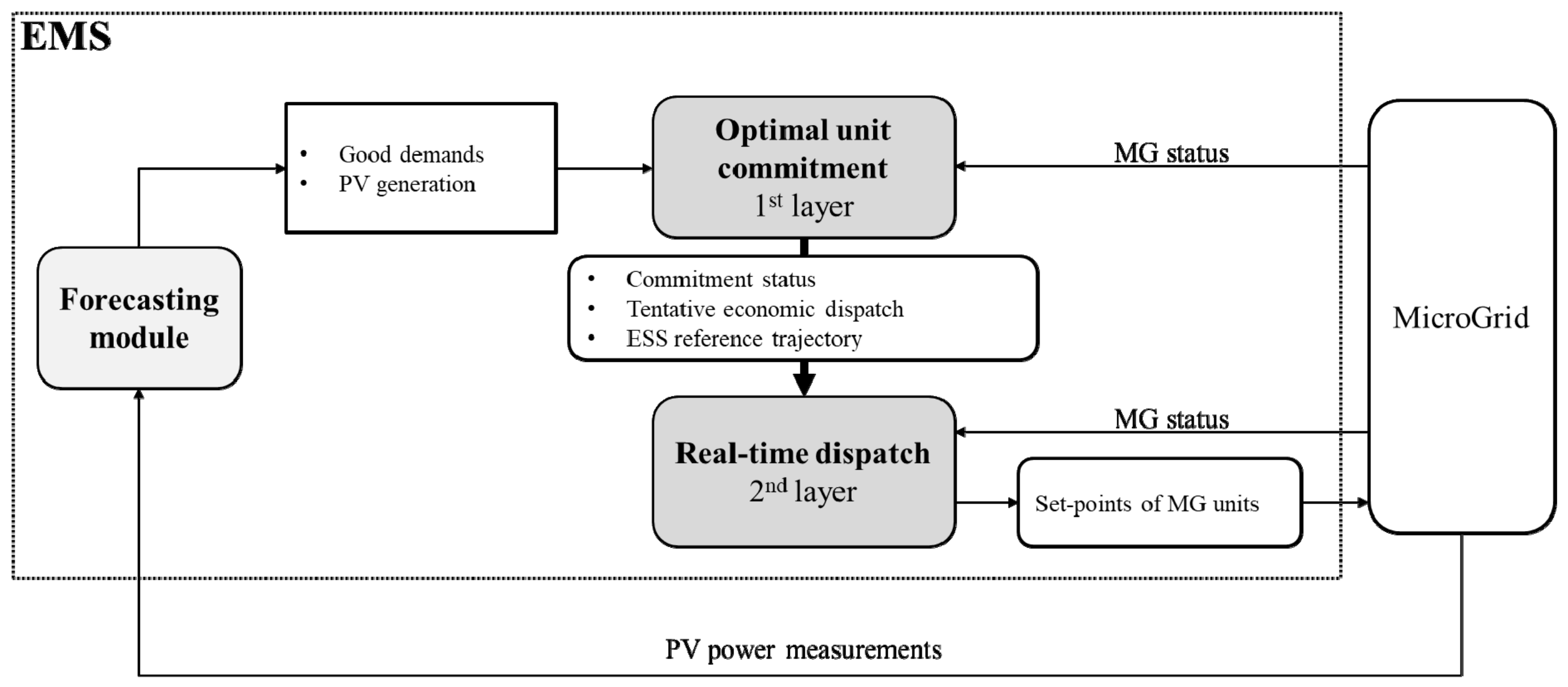

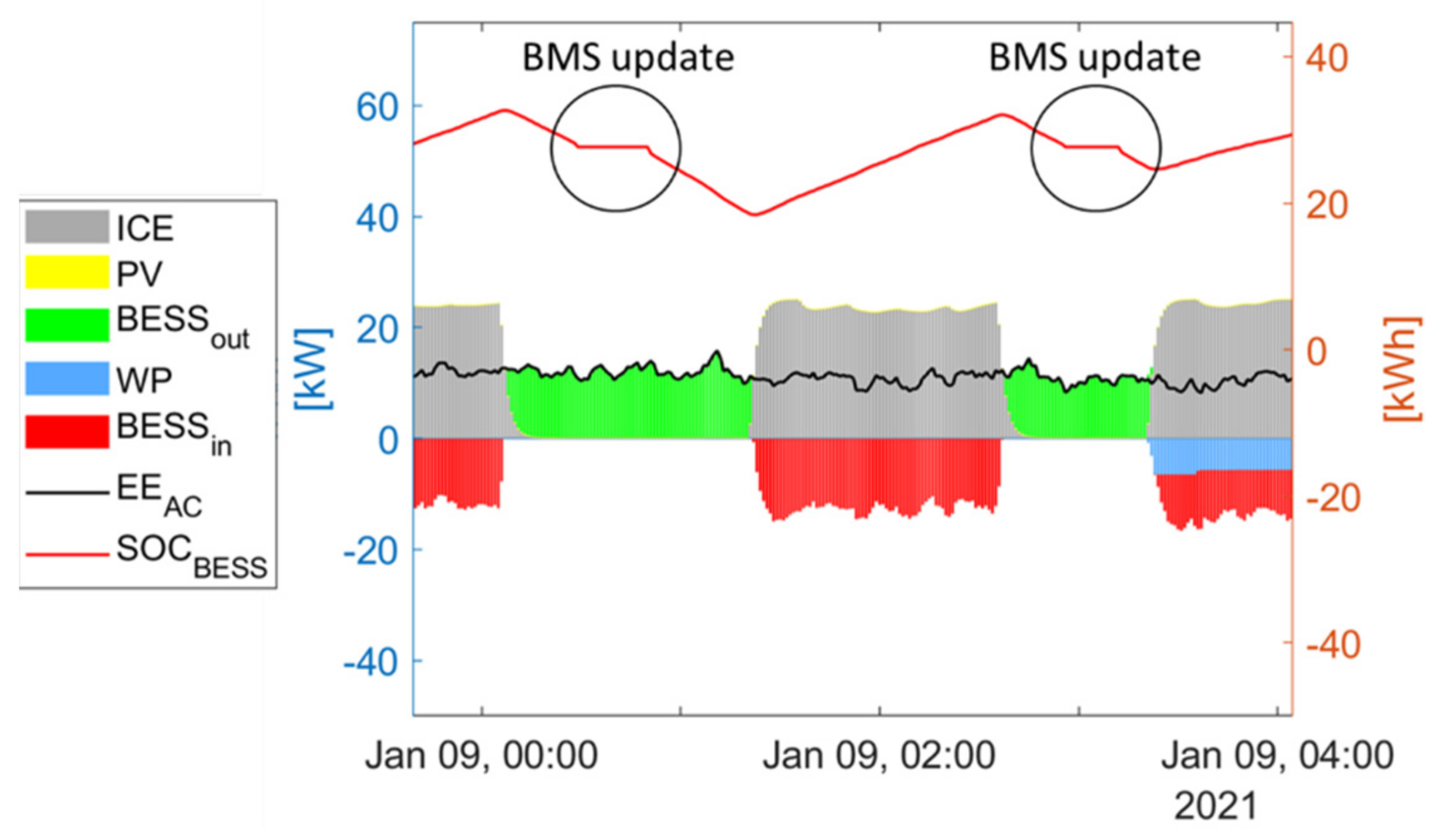
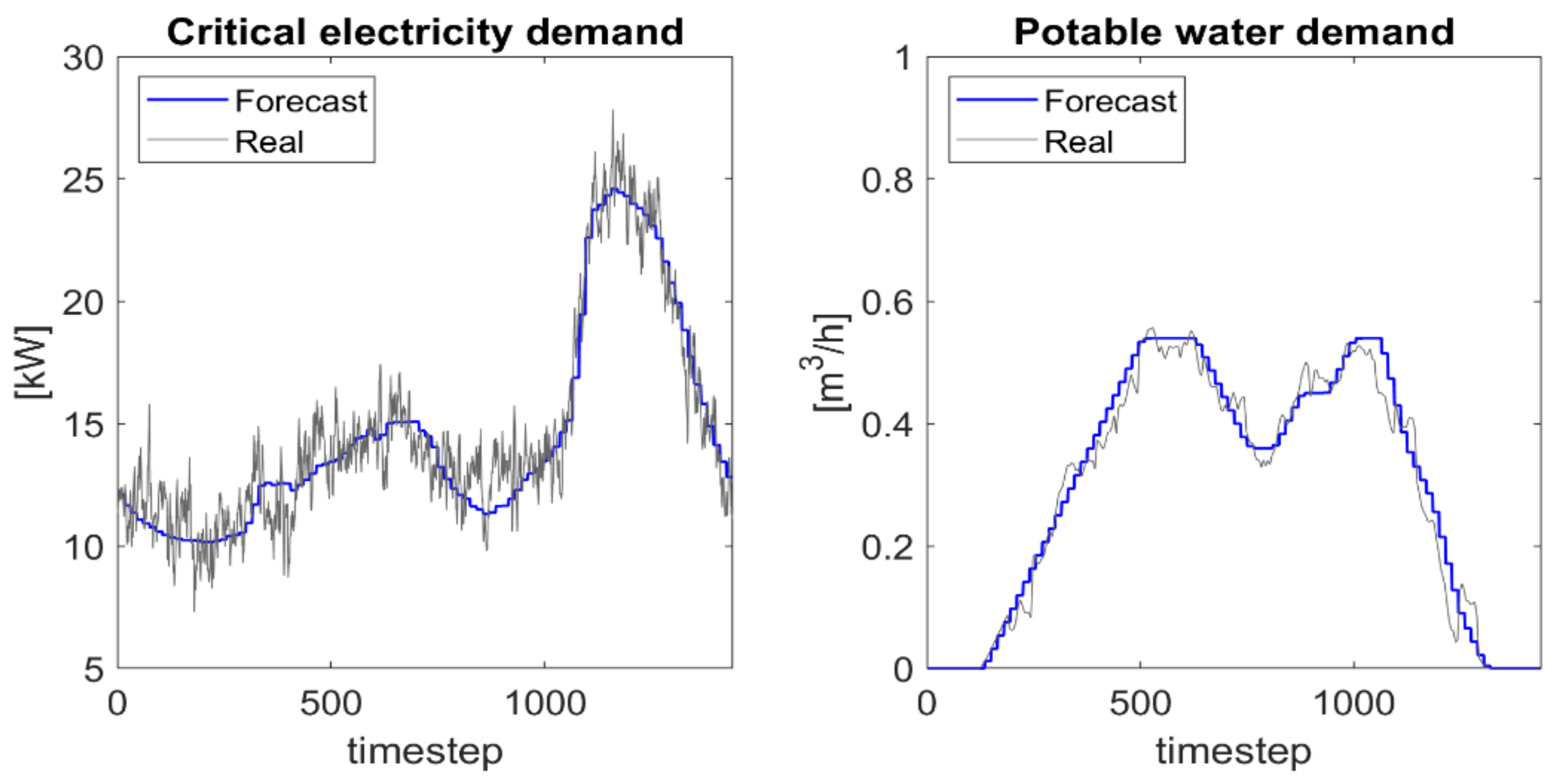
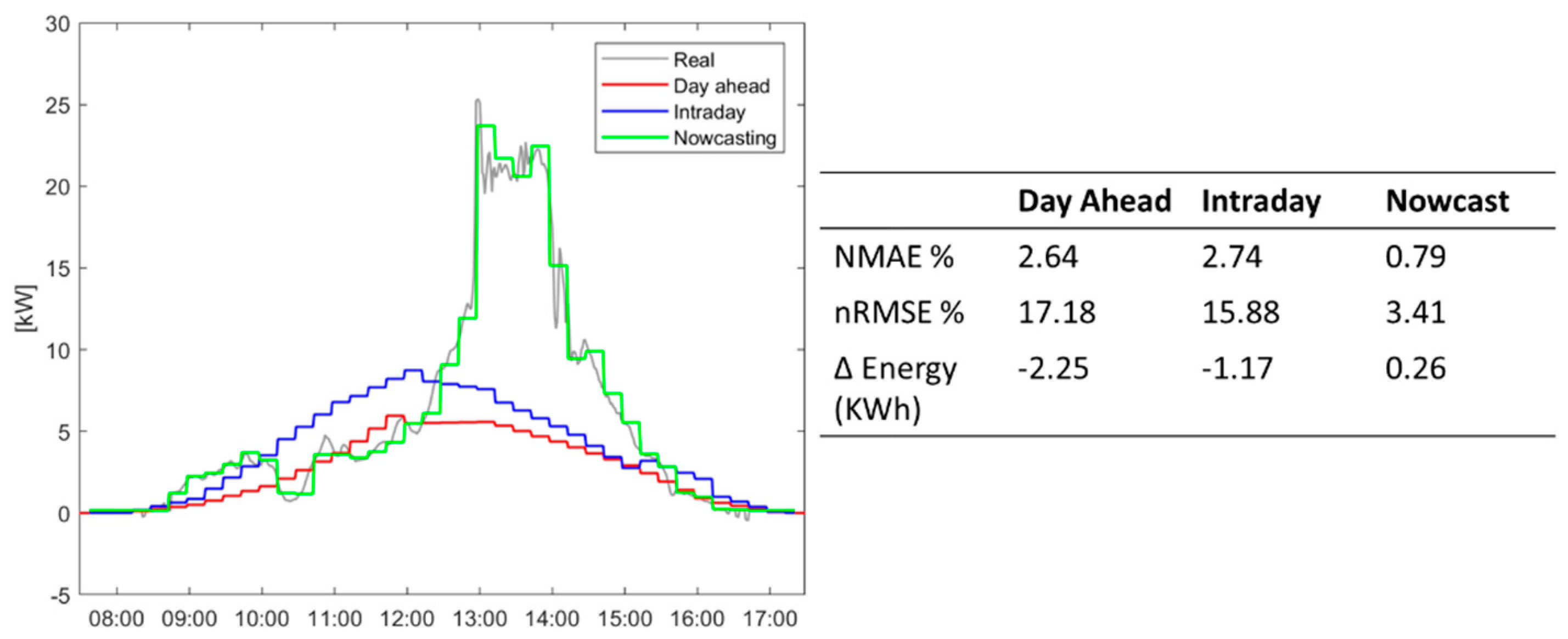
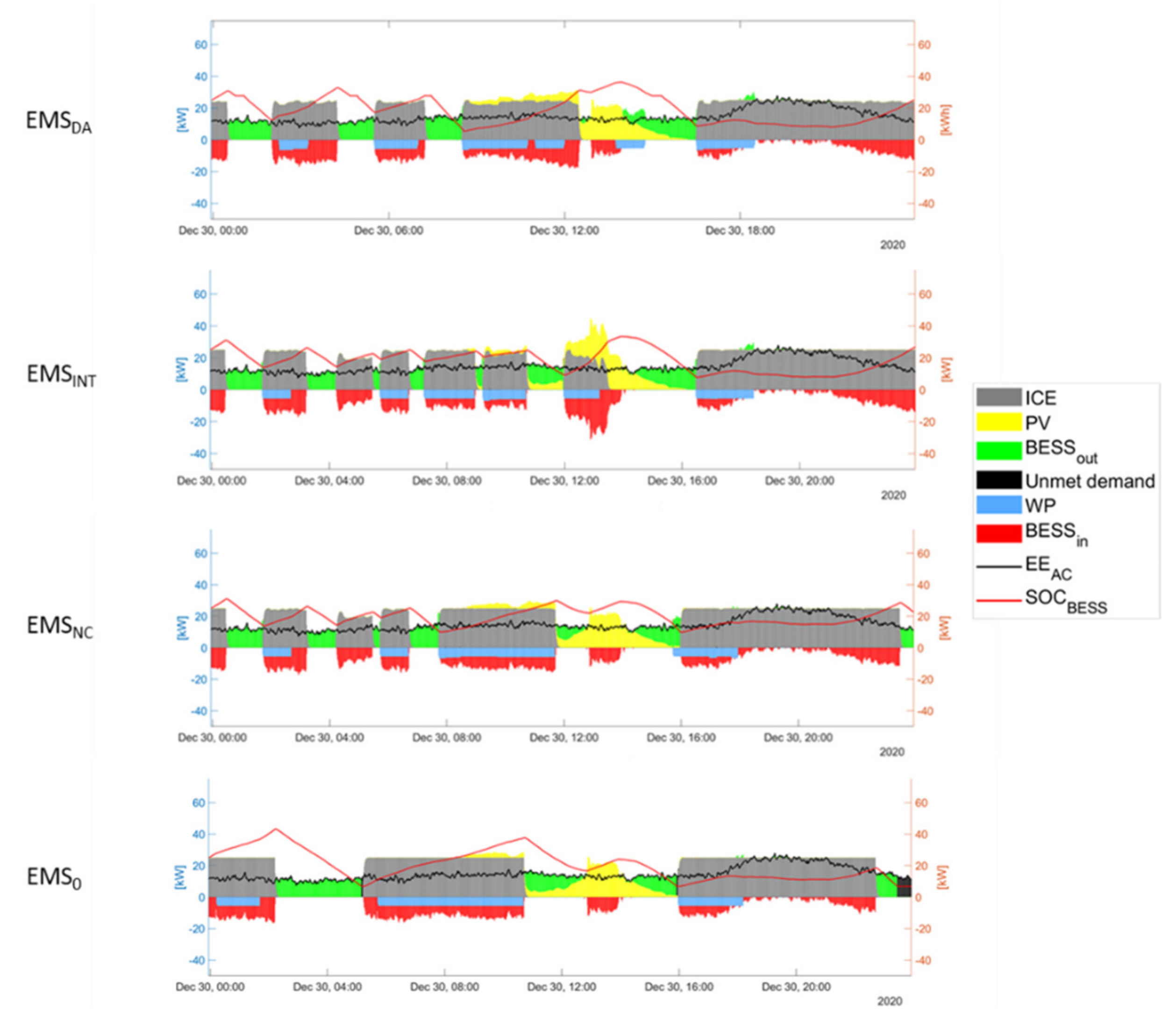
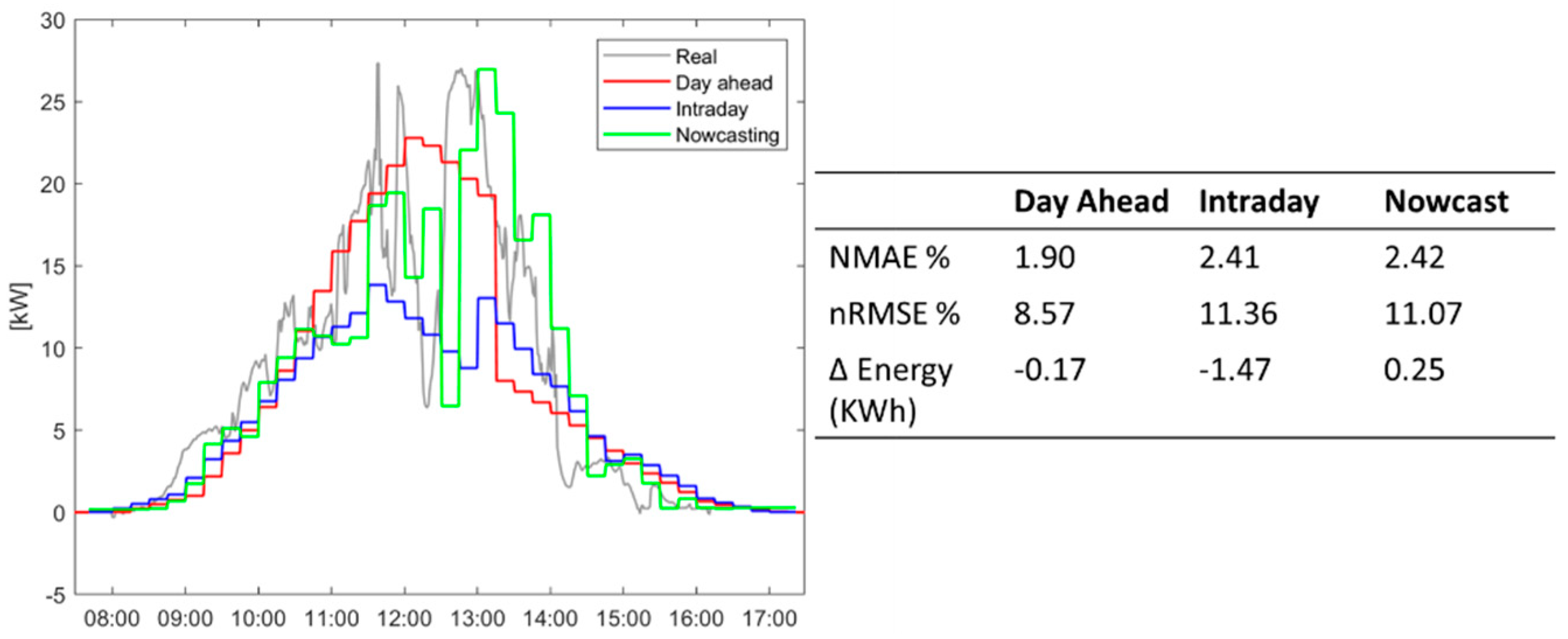
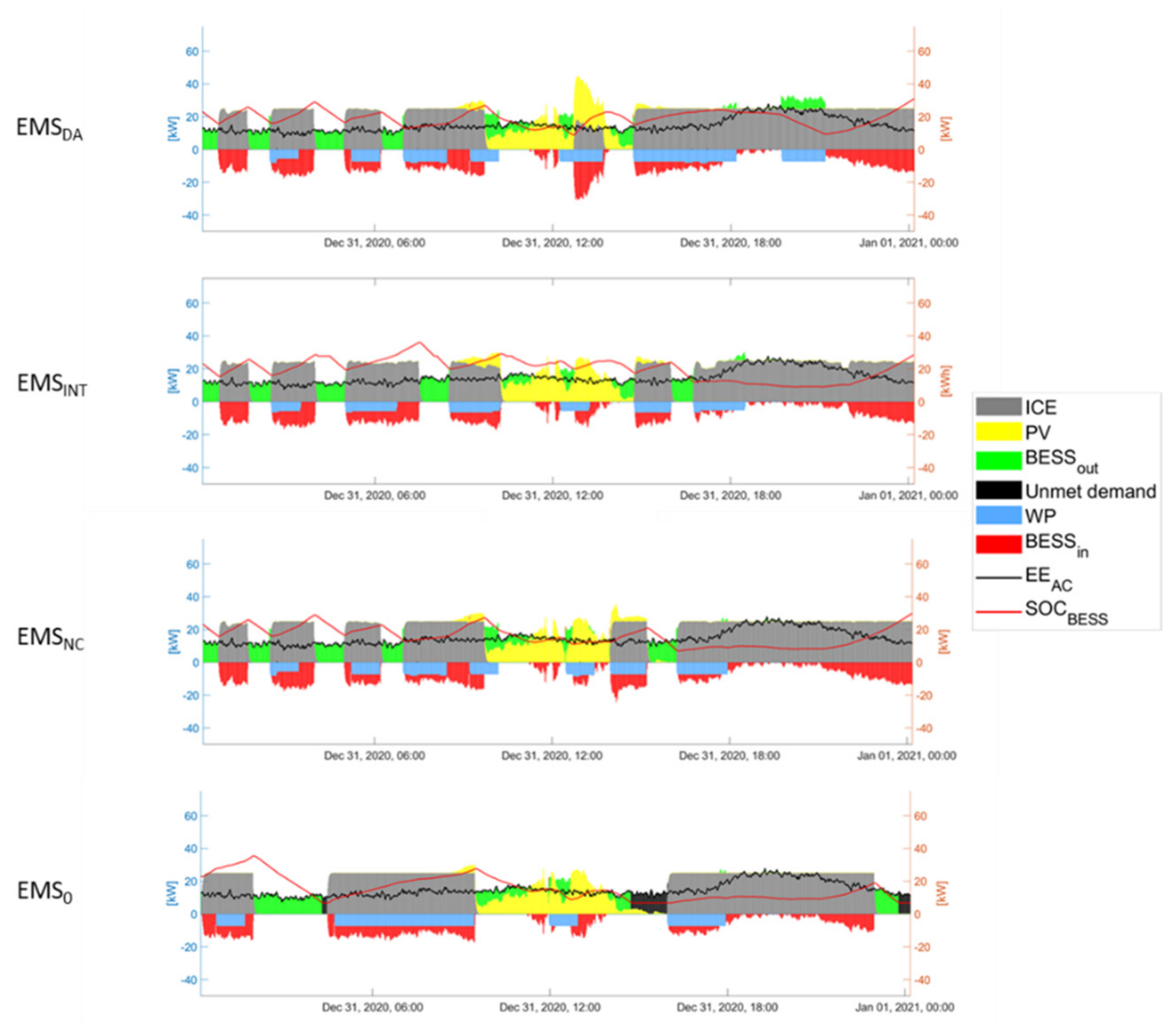
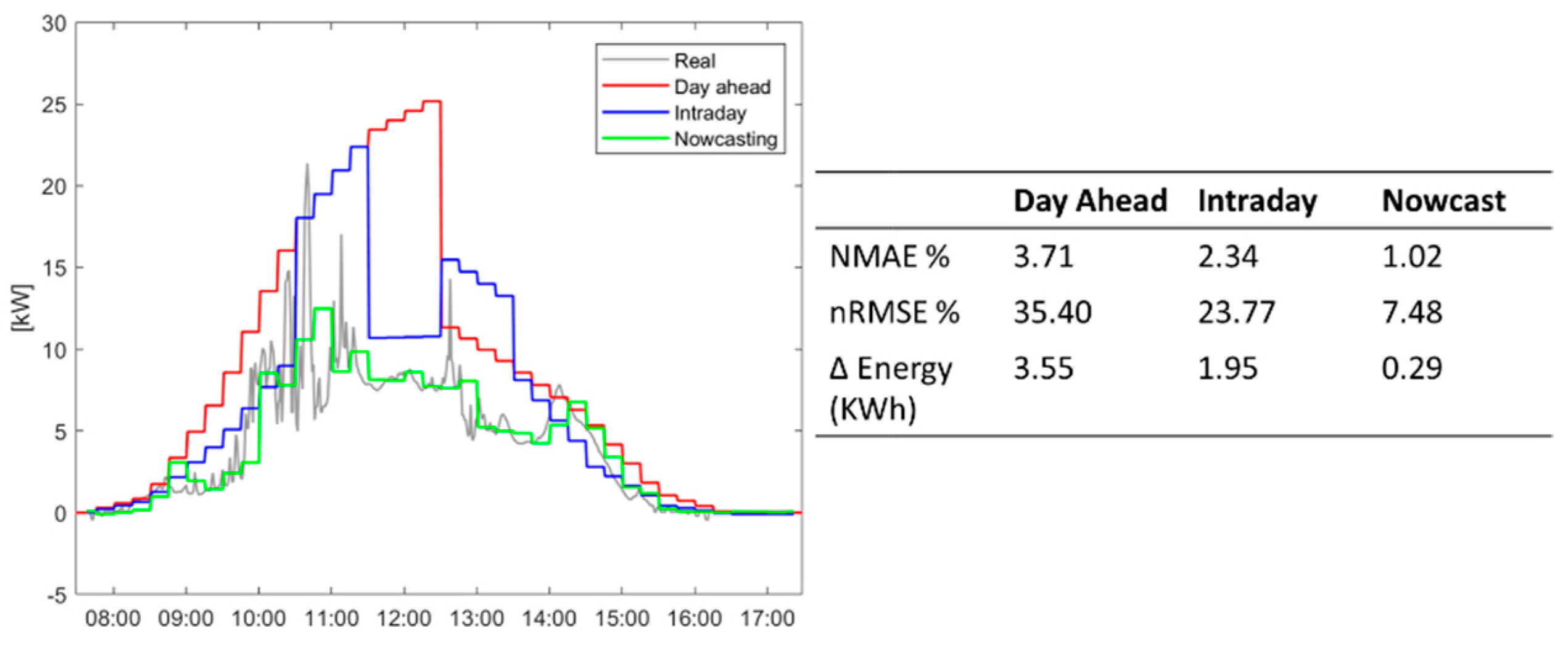

| Peak | Daily Demand | nRMSE [%] | |
|---|---|---|---|
| Critical electricity demand | 27.8 kW | 352.8 kWh | 4.69 |
| Potable water demand | 0.55 m3/h | 6.9 m3 | 5.68 |
| EMSDA | EMSINT | EMSNC | EMS0 | ||
|---|---|---|---|---|---|
| Critical electricity demand | (kWh) | 352.8 | 352.8 | 352.8 | 352.8 |
| Total electricity demand | (kWh) | 403.2 | 402.6 | 402.2 | 401.4 |
| ICE generation | (kWh) | 385.3 | 382.0 | 397.0 | 363.5 |
| PV generation | (kWh) | 55.7 | 55.7 | 55.7 | 55.7 |
| RES curtailment | (kWh) | 0.0 | 0.0 | 0.0 | 0.0 |
| Unmet electricity demand | (kWh) | 0.0 | 0.0 | 0.0 | 7.4 |
| Battery discharge | (kWh) | 75.3 | 64.9 | 68.9 | 71.4 |
| Battery charge | (kWh) | 110.4 | 99.5 | 118.7 | 96.4 |
| Final BESS SOC | (% ) | 37.2 | 24.6 | 44.7 | 10.0 |
| Final water tank content | (m3) | 0.234 | 0.260 | 0.227 | 0.271 |
| BMS discrepancy | (kWh) | 13.3 | --- | --- | --- |
| Fuel Consumption | (Nm3) | 118.9 | 119.5 | 122.0 | 111.2 1 |
| Corrected Fuel Consumption | (Nm3) | 122.8 | 121.3 | 120.0 | --- |
| Δ fuel consumption | (% ) | --- | −1.27 | −2.28 | --- |
| EMSDA | EMSINT | EMSNC | EMS0 | ||
|---|---|---|---|---|---|
| Critical electricity demand | (kWh) | 352.5 | 352.5 | 352.5 | 352.5 |
| Total electricity demand | (kWh) | 432.5 | 403.9 | 414.0 | 416.5 |
| ICE generation | (kWh) | 409.5 | 368.2 | 389.3 | 343.6 |
| PV generation | (kWh) | 76.6 | 77.0 | 76.5 | 76.8 |
| RES curtailment | (kWh) | 0.0 | 0.0 | 0.0 | 0.0 |
| Unmet electricity demand | (kWh) | 0.0 | 0.0 | 0.0 | 20.2 |
| Battery discharge | (kWh) | 65.6 | 65.0 | 60.5 | 56.8 |
| Battery charge | (kWh) | 118.4 | 104.8 | 111.6 | 80.6 |
| Final BESS SOC | (% ) | 46.2 | 42.1 | 44.6 | 10.0 |
| Final water tank content | (m3) | 2.260 | 0.081 | 0.262 | 0.268 |
| BMS discrepancy | (kWh) | --- | 7.38 | --- | --- |
| Fuel Consumption | (Nm3) | 126.4 | 114.1 | 119.7 | 105.2 1 |
| Corrected Fuel Consumption | (Nm3) | 118.3 | 115.1 | 117.5 | --- |
| Δ fuel consumption | (% ) | --- | −2.70 | −0.70 | --- |
| EMSDA | EMSINT | EMSNC | EMS0 | ||
|---|---|---|---|---|---|
| Critical electricity demand | (kWh) | 351.7 | 351.7 | 351.7 | 351.7 |
| Total electricity demand | (kWh) | 399.8 | 403.5 | 403.3 | 399.6 |
| ICE generation | (kWh) | 391.6 | 402.0 | 404.1 | 299.8 |
| PV generation | (kWh) | 44.1 | 44.2 | 44.4 | 44.3 |
| RES curtailment | (kWh) | 0.0 | 0.0 | 0.0 | 0.1 |
| Unmet electricity demand | (kWh) | 0.0 | 0.0 | 0.0 | 70.5 |
| Battery discharge | (kWh) | 69.4 | 76.1 | 73.8 | 61.4 |
| Battery charge | (kWh) | 104.9 | 118.2 | 116.5 | 75.9 |
| Final BESS SOC | (% ) | 26.5 | 34.3 | 44.8 | 10.0 |
| Final water tank content | (m3) | 0.471 | 0.894 | 0.893 | 0.470 |
| BMS discrepancy | (kWh) | --- | --- | 7.3 | --- |
| Fuel consumption | (Nm3) | 123.2 | 124.5 | 125.3 | 91.7 1 |
| Corrected fuel consumption | (Nm3) | 125.7 | 124.0 | 124.9 | --- |
| Δ fuel consumption | (% ) | --- | −1.35 | −0.66 | --- |
| EMSDA | EMSINT | EMSNC | |||
|---|---|---|---|---|---|
| Day 1 | nMAE | (% ) | 2.64 | 2.74 | 0.79 |
| nRMSE | (% ) | 17.18 | 15.88 | 3.41 | |
| Corrected Fuel Consumption | (Nm3) | 122.8 | 121.3 | 120.0 | |
| Δ fuel consumption | (% ) | --- | −1.27 | −2.28 | |
| Day 2 | nMAE | (% ) | 1.9 | 2.41 | 2.42 |
| nRMSE | (% ) | 8.57 | 11.36 | 11.07 | |
| Corrected Fuel Consumption | (Nm3) | 118.3 | 115.1 | 117.5 | |
| Δ fuel consumption | (% ) | --- | −2.70 | −0.70 | |
| Day 3 | nMAE | (% ) | 3.71 | 2.34 | 1.02 |
| nRMSE | (% ) | 35.4 | 23.77 | 7.48 | |
| Corrected Fuel Consumption | (Nm3) | 125.7 | 124.0 | 124.9 | |
| Δ fuel consumption | (% ) | --- | −1.35 | −0.66 |
Publisher’s Note: MDPI stays neutral with regard to jurisdictional claims in published maps and institutional affiliations. |
© 2021 by the authors. Licensee MDPI, Basel, Switzerland. This article is an open access article distributed under the terms and conditions of the Creative Commons Attribution (CC BY) license (http://creativecommons.org/licenses/by/4.0/).
Share and Cite
Polimeni, S.; Nespoli, A.; Leva, S.; Valenti, G.; Manzolini, G. Implementation of Different PV Forecast Approaches in a MultiGood MicroGrid: Modeling and Experimental Results. Processes 2021, 9, 323. https://doi.org/10.3390/pr9020323
Polimeni S, Nespoli A, Leva S, Valenti G, Manzolini G. Implementation of Different PV Forecast Approaches in a MultiGood MicroGrid: Modeling and Experimental Results. Processes. 2021; 9(2):323. https://doi.org/10.3390/pr9020323
Chicago/Turabian StylePolimeni, Simone, Alfredo Nespoli, Sonia Leva, Gianluca Valenti, and Giampaolo Manzolini. 2021. "Implementation of Different PV Forecast Approaches in a MultiGood MicroGrid: Modeling and Experimental Results" Processes 9, no. 2: 323. https://doi.org/10.3390/pr9020323








